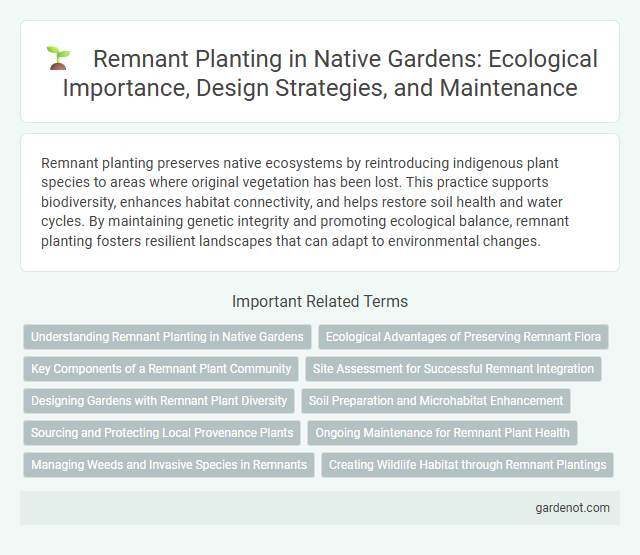Remnant planting preserves native ecosystems by reintroducing indigenous plant species to areas where original vegetation has been lost. This practice supports biodiversity, enhances habitat connectivity, and helps restore soil health and water cycles. By maintaining genetic integrity and promoting ecological balance, remnant planting fosters resilient landscapes that can adapt to environmental changes.
Understanding Remnant Planting in Native Gardens
Remnant planting involves preserving and integrating native plant species that naturally occur in a specific area, enhancing biodiversity and ecosystem stability within native gardens. These native remnants act as a genetic reservoir, supporting local wildlife and maintaining regional ecological balance. By prioritizing remnant plants, gardeners promote habitat restoration and resilience against invasive species.
Ecological Advantages of Preserving Remnant Flora
Preserving remnant flora enhances biodiversity by maintaining native plant species that support local wildlife habitats and strengthen ecosystem resilience. These remnants act as genetic reservoirs, enabling adaptation to environmental changes and fostering natural regeneration processes. Protecting remnant vegetation also improves soil health, water quality, and carbon sequestration, contributing significantly to ecological stability.
Key Components of a Remnant Plant Community
A remnant plant community consists of native species that have persisted since pre-settlement times, reflecting historical biodiversity and ecological balance. Key components include dominant canopy trees, understory shrubs, herbaceous groundcovers, and native grasses, each supporting habitat complexity and species interactions. Preserving genetic integrity and natural regeneration processes is essential for maintaining ecosystem resilience and function within remnant plant communities.
Site Assessment for Successful Remnant Integration
Site assessment for successful remnant planting involves analyzing soil composition, hydrology, and existing vegetation to ensure compatibility with native species. Evaluating microclimate conditions and potential invasive species presence helps tailor restoration efforts for optimal growth and biodiversity support. Thorough site analysis guides the strategic placement and management of remnant plants, enhancing ecosystem resilience and natural regeneration.
Designing Gardens with Remnant Plant Diversity
Designing gardens with remnant plant diversity involves incorporating native species that naturally occur in local ecosystems, preserving genetic diversity and supporting wildlife habitats. Remnant planting enhances ecological resilience by maintaining plant community structure and promoting soil health through deep-rooted native perennials and shrubs. Integrating these species into garden design helps restore regional biodiversity and fosters sustainable, low-maintenance landscapes reflective of the original habitat.
Soil Preparation and Microhabitat Enhancement
Effective remnant planting requires thorough soil preparation, including the removal of invasive species and the addition of organic matter to restore nutrient balance and improve soil structure. Enhancing microhabitats through the creation of mulch layers, integrating coarse woody debris, and establishing microtopography supports native seed germination and encourages biodiversity. These practices increase soil microbial activity and moisture retention, fostering a resilient environment for native plant establishment.
Sourcing and Protecting Local Provenance Plants
Sourcing local provenance plants ensures genetic diversity and resilience by using native species adapted to the specific regional ecosystem. Protecting remnant plants involves preserving these original, naturally occurring populations that serve as vital seed sources for restoration projects. Maintaining these local plant genetic reservoirs supports biodiversity, promotes ecological stability, and enhances the success of native planting initiatives.
Ongoing Maintenance for Remnant Plant Health
Ongoing maintenance of remnant plant health involves regular monitoring for invasive species, pest infestations, and disease outbreaks to ensure ecosystem stability. Implementing targeted weed control and selective pruning facilitates native species regeneration and habitat resilience. Soil health assessments and adaptive management practices support long-term plant community vitality in remnant vegetation areas.
Managing Weeds and Invasive Species in Remnants
Managing weeds and invasive species in remnant native plantings requires regular monitoring and targeted removal to preserve biodiversity and ecological integrity. Employing manual weeding, selective herbicides, and strategic revegetation with native species effectively suppresses invasive populations and supports ecosystem resilience. Maintaining the health of native remnants enhances habitat quality and prevents degradation caused by aggressive non-native flora.
Creating Wildlife Habitat through Remnant Plantings
Remnant planting enhances wildlife habitat by preserving native vegetation patches that support diverse species and ecosystem functions. These plantings provide crucial food sources, shelter, and breeding grounds for birds, insects, and small mammals, maintaining regional biodiversity. Integrating remnant native plants restores ecological balance, supports pollinators, and strengthens habitat connectivity across fragmented landscapes.
Remnant planting Infographic

 gardenot.com
gardenot.com